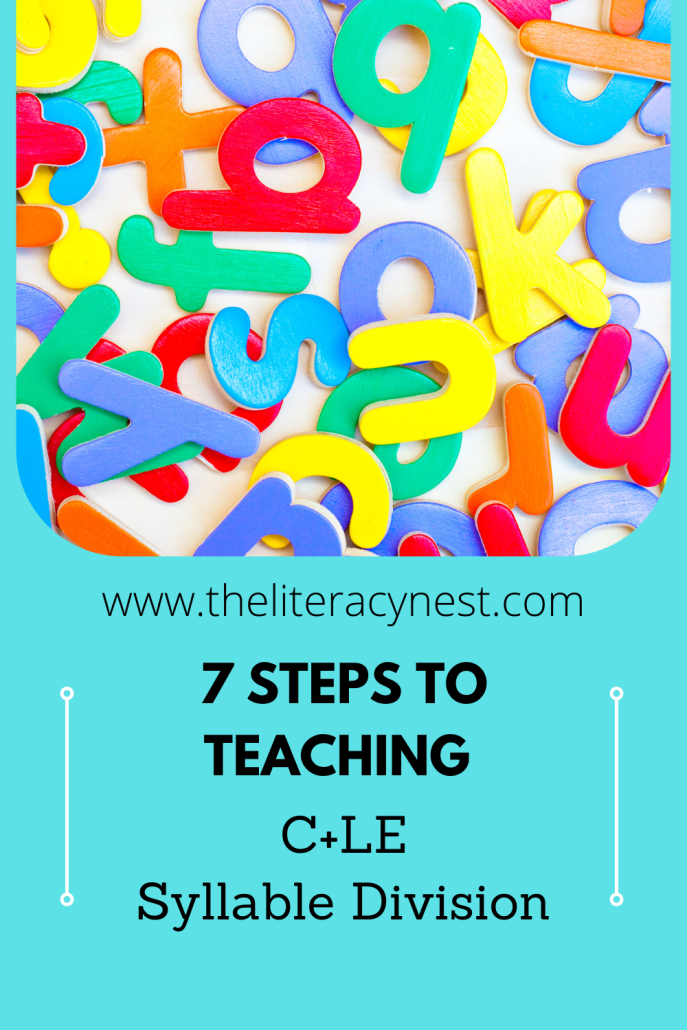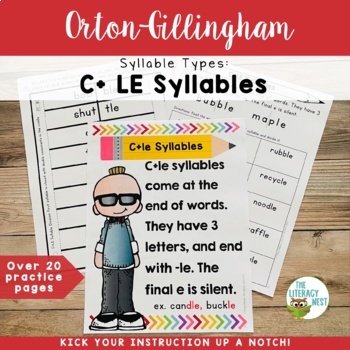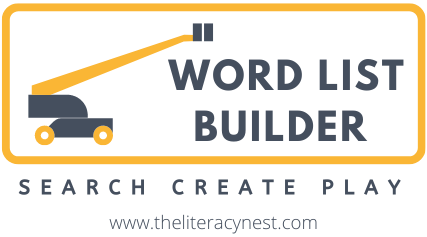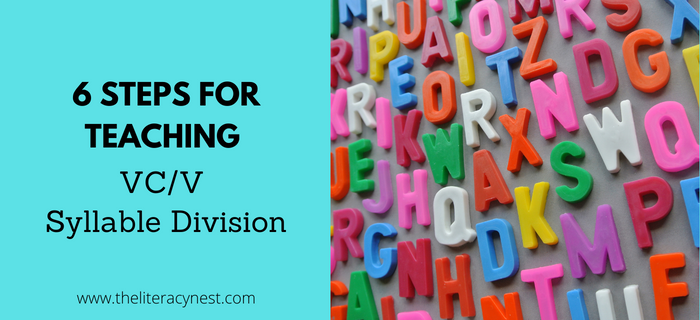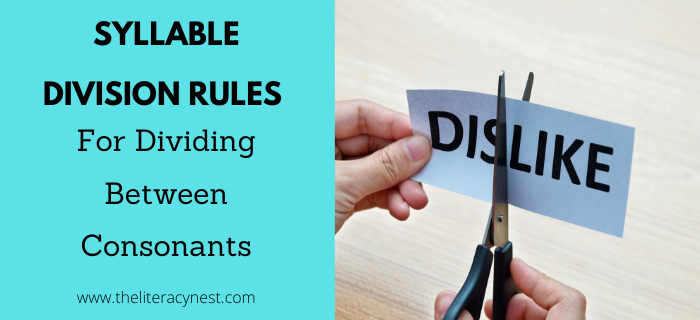7 Steps for Teaching C+LE Syllable Division
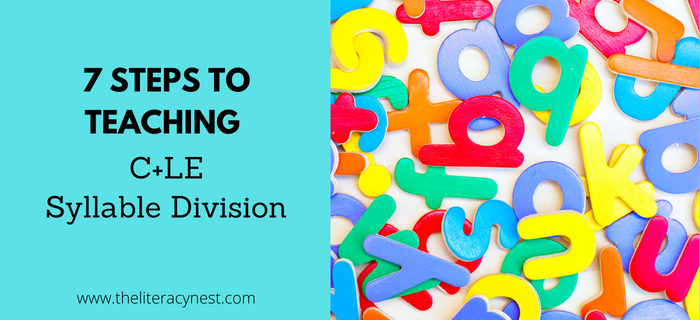
This post about C+LE syllable division is the next in our series on syllable division. The easiest and most common type of syllable division is the division between consonants. The next most common are V/CV syllable division and VC/V, also discussed previously.
Check out the previous posts in this series:
- Syllable Division Between Consonants
- 7 Steps for Teaching V/CV Syllable Division
- 6 Steps for Teaching VC/V Syllable Division
Teaching syllable division rules is important because it provides students with a procedure for decoding multi-syllable words allowing them to read a much wider array of books and stories.
Dividing words with consonant-l-e syllables is a bit different than the syllable division that we have talked about previously.
When to Teach C+LE Syllable Division
Dividing syllables with consonant-l-e needs to be taught in conjunction with the syllable type. By definition -cle syllables can only exist as part of a multisyllabic word. This represents a significant shift in the identification of other syllable types. Also, the division of these words helps to determine the syllable type of the first syllable and therefore the pronunciation of the first syllable of the word.
How to Teach C+LE Syllable Division
I typically teach consonant-l-e in a few different stages with closed syllables, open syllables, r-controlled and vowel team, and then some tricky applications such as -nkle, -ngle, -ckle, and -stle. Consonant-l-e is a syllable type, but it is also known as a final stable syllable.
Finally, because it is at the end of the word and stable because it remains consistent for spelling and pronunciation. Perhaps the hardest part is for students to become efficient at recognizing a -cle syllable when they see one.
Step 1: Write the word.
Write a word in large letters on a chalkboard or whiteboard. If teaching remotely, it is helpful to stretch the word so the spacing between letters is loose on the slide or app you are using.
Step 2: Underline the vowels.
Ask your student to underline the vowels in the multisyllabic word.
Step 3: Touch the vowels.
Ask your student to place their left hand on the first vowel and their right hand on the second vowel. It is helpful to adjust your instructions here to the individual child. For children that struggle with oral language, modeling or providing hand-over-hand support to complete this step may be helpful.
Step 4: Verbalize what is between the vowels.
Ask the student to look in between their fingers and verbalize what they see. This could be one or more consonants and le.
Step 5: Find the e and count back three.
Explain to the student that consonant-l-e is a special type of syllable. When you see one, there is a little rhyme that can help you remember how to divide. “Find the e and count back three.” To identify this as a final stable syllable, I like to have students divide using a bracket as in lit[tle.
Step 6: Identify the syllable types.
Take the further step of identifying the syllable type in the first syllable and marking the vowel sound with a breve.
Step 7: Review as needed.
In subsequent lessons, I would repeat this process with open syllables, r-controlled, and vowel team (although there are very few of these words). Be sure to draw particular attention to words in which the middle consonant is doubled. When spelling, we can accurately predict the doubling of that consonant when we hear a short vowel in the first syllable and a single consonant sound as in wiggle, little, middle, and fizzle.
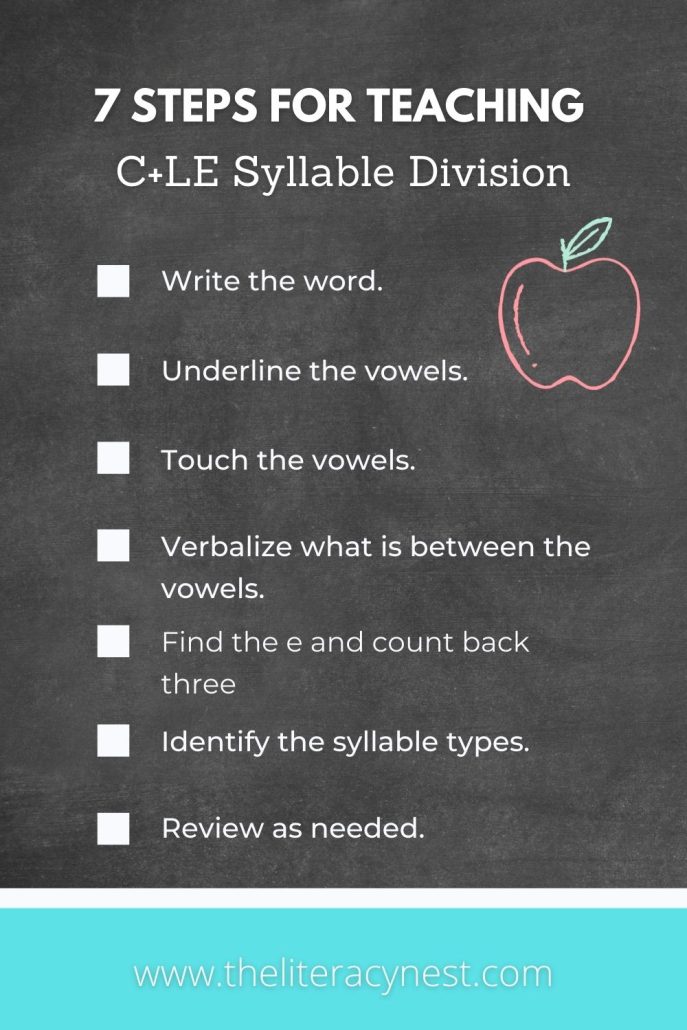
Download a printable version of this c+le syllable division checklist.
More Practice
I like to provide students more practice with closed syllables + CLE and open syllables +CLE in isolation before mixing them. Some examples of closed syllables + CLE include sample, puddle, and fumble. Open syllables + CLE include bugle, table, and title.
It is important for students to have the chance to build automaticity through practice. Following the steps of underlining vowels and marking syllable division is one way to reinforce this. Other multisensory ways to practice include using linking cubes and cutting word cards. Encoding practice using index cards or small whiteboards is also helpful. I recommend marking short vowels with a breve and long vowels with a macron as well as indicating syllable type. Begin with a more hands-on approach and gradually move to less intensive methods as the process becomes more automatic.
While initially I would avoid nkle, ngle, ckle and stle words, eventually we need to encourage our students to be flexible. When introducing these tricky situations, I find nkle and ngle pair nicely for instruction.
Advanced Practice
More advanced students may be able to handle -ckle as part of the same lesson. We have taught students that chunks such as ank, ang, ing, and onk are kept together when dividing syllables. Likewise, we have taught them that digraphs are kept together.
- As before I would start with a word in large print and ask students to divide the words according to the rule “find the e and count back 3”.
- Point out to students if they don’t already notice that in dividing the syllables according to that rule, we are breaking up the chunk or digraph.
- What seems to make the most sense to students is that the first syllable with the chunk or digraph and the second syllable with the cle pattern are sharing the 3rd letter. The chunk needs it because separating the chunk is too difficult and the -cle syllable needs it to be a complete syllable. When they divide the syllable with the bracket, they may choose to underline the chunk like this tan[gle or buc[kle.
- Finally, I teach -stle as in castle and whistle separately as an unusual circumstance. When you see the pattern -stle, the t is silent. I avoid using this pattern in spelling except with familiar words.
Make it Fun!
Almost any game can be used to practice syllable division, especially for reading. The only limit is your imagination.
A simple variation on “War” assigns point values to word cards. The player with the higher # keeps the cards. Alternatively, you can spread out the cards face down. Players take turns flipping a card and tallying their point total. Students often need additional practice with reading and spelling closed syllable words + cle and open syllable words with cle correctly.
Dividing words on cards and physically sorting the divided words is helpful to building rapid recognition of syllable patterns.
Are you looking for resources to teach C+LE syllable division?
You can use this syllable types resource to teach C+LE syllables. Teaching syllable types and syllable practice will prepare your student for syllabicating and decoding multisyllabic words.
Save time searching for words with C+LE syllable division, check out Word List Builder!
With Word List Builder, you can search for C+LE words, build your folder of words and create templates. Start your 14-day trial today!
